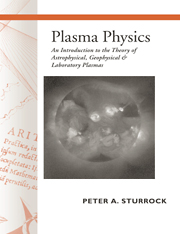Book contents
- Frontmatter
- Contents
- Preface
- 1 Introduction
- 2 Basic concepts
- 3 Orbit theory – uniform fields
- 4 Adiabatic invariants
- 5 Orbit theory
- 6 Electromagnetic waves in a cold electron plasma
- 7 Electromagnetic waves in an electron-ion plasma
- 8 Two-stream instability
- 9 Electrostatic oscillations in a plasma of nonzero temperature
- 10 Collision theory
- 11 MHD equations
- 12 Magnetohydrodynamics
- 13 Force-free magnetic-field configurations
- 14 Waves in MHD systems
- 15 Magnetohydrodynamic stability
- 16 Variation principle for MHD systems
- 17 Resistive instabilities
- 18 Stochastic processes
- 19 Interaction of particles and waves
- Appendix A Units and constants
- Appendix B Group velocity
- Appendix C Amplifying and evanescent waves, convective and absolute instability
- References
- Author index
- Subject index
Preface
Published online by Cambridge University Press: 05 June 2012
- Frontmatter
- Contents
- Preface
- 1 Introduction
- 2 Basic concepts
- 3 Orbit theory – uniform fields
- 4 Adiabatic invariants
- 5 Orbit theory
- 6 Electromagnetic waves in a cold electron plasma
- 7 Electromagnetic waves in an electron-ion plasma
- 8 Two-stream instability
- 9 Electrostatic oscillations in a plasma of nonzero temperature
- 10 Collision theory
- 11 MHD equations
- 12 Magnetohydrodynamics
- 13 Force-free magnetic-field configurations
- 14 Waves in MHD systems
- 15 Magnetohydrodynamic stability
- 16 Variation principle for MHD systems
- 17 Resistive instabilities
- 18 Stochastic processes
- 19 Interaction of particles and waves
- Appendix A Units and constants
- Appendix B Group velocity
- Appendix C Amplifying and evanescent waves, convective and absolute instability
- References
- Author index
- Subject index
Summary
This book is based on a series of lectures that has been given at Stanford University, for longer than I care to remember, to graduate students from several departments: Aeronautics and Astronautics, Applied Physics, Electrical Engineering, Mechanical Engineering, and Physics. The course has also formed part of the Astronomy Course Program and of the Space Science Program.
The course has changed over the years, beginning as a three-quarter sequence emphasizing laboratory and geophysical plasmas, and evolving into a two-quarter sequence emphasizing solar and other astrophysical applications. Selected material has also been offered as a one-quarter course. The course has been much improved by input from many students (in fact, the first set of lecture notes was produced by students in the class) and from a sequence of dedicated teaching assistants, notably, in recent years, Dr Anton Bergmann, Ms Lisa Porter and Dr Yuri Taranenko.
For invaluable assistance in the preparation of this text, I am indebted to Mrs Louise Meyers-Norney, who entered the text, to Dr James and Mrs Maria Klimchuk, who entered the equations, and to Dr Taeil Bai and Mr David Faust, who helped prepare the figures. Thanks are due also to Dr George Field, Dr Robert Helliwell, Dr Eric Priest and Dr Gerard Van Hoven, who kindly reviewed some of the chapters, and to Dr Simon Mitton and Ms Fiona Thomson of Cambridge University Press for their generous support.
- Type
- Chapter
- Information
- Plasma PhysicsAn Introduction to the Theory of Astrophysical, Geophysical and Laboratory Plasmas, pp. xi - xiiPublisher: Cambridge University PressPrint publication year: 1994

